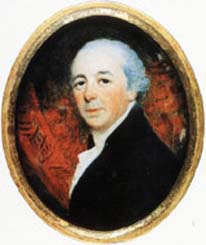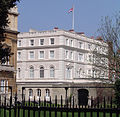John Nash (architect): Difference between revisions
| Line 62: | Line 62: | ||
*[[Park Crescent, London]] (1806, 1819-21) |
*[[Park Crescent, London]] (1806, 1819-21) |
||
*[[Regent's Park]] (1809-32) |
*[[Regent's Park]] (1809-32) |
||
*[[Trafalgar Square]] (1813-30) completely redesigned by Sir [[Charles Barry]] |
|||
*[[St. James's Park]] (1814-27) |
*[[St. James's Park]] (1814-27) |
||
*The King's Opera House on the site of [[Her Majesty's Theatre]] The Royal Opera Arcade is the only part still standing (1816-18) |
*The King's Opera House on the site of [[Her Majesty's Theatre]] The Royal Opera Arcade is the only part still standing (1816-18) |
||
| Line 87: | Line 88: | ||
*[[Marble Arch]] (1828) |
*[[Marble Arch]] (1828) |
||
*430-449 [[The Strand]] (1830) |
*430-449 [[The Strand]] (1830) |
||
*[[Trafalgar Square]] was conceived by Nash but not actually created until after his death to the designs of Sir [[Charles Barry]] |
|||
The changes wrought by John Nash on the streetscape of London are documented in the film, "John Nash and London", featuring [[Edmund N. Bacon]] and based on sections of his book ''[[Design of Cities]].'' |
The changes wrought by John Nash on the streetscape of London are documented in the film, "John Nash and London", featuring [[Edmund N. Bacon]] and based on sections of his book ''[[Design of Cities]].'' |
||
Revision as of 07:40, 22 August 2010
John Nash | |
|---|---|
 | |
| Born | John Nash 18 January 1752 |
| Died | 13 May 1835 |
| Resting place | St. James's Church, East Cowes |
| Nationality | British |
| Occupation | Architect |
| Buildings | Buckingham Palace |

John Nash (18 January 1752 – 13 May 1835) was an Anglo-Welsh architect responsible for much of the layout of Regency London.
Biography
Born on the 18th January 1752 Lambeth, London, as the son of a Welsh millwright, Nash trained with architect Sir Robert Taylor, he established his own practice in 1777, but his own career was initially unsuccessful and short-lived. After inheriting £1000[1] in 1778 from his uncle Thomas, he invested the money in 1777-78 in building his first known independent works in Bloomsbury building 15-17 Bloomsbury Square and 66-71 Great Russell Street. But the property failed to let and he was declared bankrupt in 1783 and left London in 1784 to live in Carmarthen, where his mother had retired to, her family being from the area. His first major work in the area being the Gaol at Carmarthen 1789-92. He also designed a series of medium sized country houses in south-west Wales including Llanerchaeron. He met Humphry Repton at Hafod in 1795, he formed a successful partnership with the landscape garden designer. One of their early commissions was at Corsham Court. The pair would collaborate to carefully place the Nash-designed building in grounds designed by Repton. Eventually, Nash returned to work in London, in 1795. The partnership ended in 1800 under recriminations[2].
His first significant commission on returning to London in 1795-6 was Hereford gaol. In June 1797 he moved into 28 Dover Street a building of his own design, he built an even bigger house next door at 29 into which he moved the following year. Nash married Mary Ann Bradley on the 17th December 1798 at St George's, Hanover Square[3]. The bride was 25 years old. In 1798 he purchased a plot of land of 30 acres at East Cowes[4]. On the land he erect 1798-1802 East Cowes Castle as his residence. This was the first of a series of picturesque Gothic castles that he would design.
In 1806 Nash was appointed architect to the Surveyor General of Woods, Forests, Parks, and Chases. From 1810 Nash would take very few private commissions[5] Nash's work came to the attention of the Prince Regent (later King George IV) and for the rest of his career he would largely work for the Prince. His first major commissions in 1811 from the Prince was Regent Street and the development of an area then known as Marylebone Park. With the Regent's backing (and major inputs from Repton), Nash created a master plan for the area, put into action from 1818 onwards, which stretched from St James’s northwards and included Regent Street, Regent's Park and its neighbouring streets, terraces and crescents of elegant town houses and villas. Nash did not complete all the detailed designs himself; in some instances, completion was left in the hands of other architects such as James Pennethorne and the young Decimus Burton. Nash was employed by the Prince to develop his Ocean Pavilion Palace in Brighton, originally designed by Henry Holland. By the early 19th century Nash finished his work on the Ocean Pavilion, which was now transformed into the Royal Pavilion. The Royal Pavilion still stands in Brighton today.
Nash was also a director of the Regent's Canal Company set up in 1812 to provide a canal link from west London to the River Thames in the east. Nash's masterplan provided for the canal to run around the northern edge of Regent's Park; as with other projects, he left its execution to one of his assistants, in this case James Morgan. The first phase of the Regent's Canal opened in 1816.
Together with Robert Smirke and Sir John Soane, he became an official architect to the Office of Works in 1813.
Further London commissions for Nash followed, including the remodelling of Buckingham House to create Buckingham Palace (1825–1835), plus the Royal Mews and Marble Arch (originally designed as a triumphal arch to stand at the entrance to Buckingham Palace. There is an urban myth which says that it was found to be too narrow for the royal State Coach and was moved in 1851 to its current location at the western end of Oxford Street). The arch was moved when the fourth wing was built, designed by Edward Blore, at the request of Queen Victoria whose growing family required additional domestic space. Marble Arch became the entrance to Hyde Park and The Great Exhibition.
He advised on work to the buildings of Jesus College, Oxford, for which he required no fee but asked that the college should commission a portrait of him from Sir Thomas Lawrence to hang in the college hall.[6]
John Nash died in May 1835[7] and is buried at St. James's Church, East Cowes.
Work in Ireland
Nash came to work in Ireland as an architect after 1793. He designed
- Caledon House, County Tyrone, (1808-10) alterations and additions.
- Killymoon Castle, near Cookstown, County Tyrone, (1801-3).
- Kilwaughter Castle, Larne, County Antrim.[8] (1807) demolished 1951.
- Church of Ireland church in Cahir, South Tipperary.
- Swiss cottage, Cahir (1810-14).
- Shane's Castle (1812-16) burnt down 1816.
- Shanbally Castle, near Clogheen, South Tipperary (1818-19) demolished 1960.
Work in London
-
All Souls Langham Place
-
Cumberland Terrace
-
Carlton House Terrace
-
Theatre Royal Haymarket
-
Buckingham Palace Garden Front
-
Park Cescent
-
Park Square
-
Marble Arch
-
Chester Terrace
-
Clarence House
-
Former United Services Club
- Park Crescent, London (1806, 1819-21)
- Regent's Park (1809-32)
- Trafalgar Square (1813-30) completely redesigned by Sir Charles Barry
- St. James's Park (1814-27)
- The King's Opera House on the site of Her Majesty's Theatre The Royal Opera Arcade is the only part still standing (1816-18)
- Waterloo Place (1816)
- Haymarket Theatre (1820-21)
- 14-16 Regent Street (Nash's own house) (1820-21)
- York Gate (1821)
- the Church of All Souls, Langham Place (1822–25)
- Hanover Terrace (1822)
- York Terrace (1822)
- Royal Mews (1822-24)
- Sussex Place (1822-23)
- Park Square, London (1823-24)
- Park Village East & West (1823-34)
- Cambridge Terrace (1824)
- landscaped King's Road (1824)
- Ulster Terrace (1824)
- Buckingham Palace the state rooms and western front (1825-30)
- Chester Terrace (1825)
- Clarence House (1825-27)
- Cumberland Terrace (1826)
- former United Services Club Pall Mall now Institute of Directors(1826-28)
- Gloucester Terrace (1827)
- Carlton House Terrace (1827–1833)
- Marble Arch (1828)
- 430-449 The Strand (1830)
The changes wrought by John Nash on the streetscape of London are documented in the film, "John Nash and London", featuring Edmund N. Bacon and based on sections of his book Design of Cities.
Other architectural work
-
Llanacheron
-
Blaise Hamlet
-
Cronkhill
-
Caerhays Castle
-
The Royal Pavilion
Elsewhere in England and Wales, his work included:
- East Cowes Castle on the Isle of Wight – his home for many years (1798-1802)
- rebuilding of the Royal Pavilion at Brighton (1815–1822)
- Blaise Hamlet, Bristol
- Grovelands Park, Enfield, Middlesex
- Llanerchaeron, Ciliau Aeron, Ceredigion
- Foley House, Haverfordwest, Pembrokeshire
- All Souls Church, Langham Place on Regent Street
- Cronkhill, near Shrewsbury, Shropshire. First Italianate villa in Britain.
- Caerhays Castle, Cornwall (1808)[9]
- Ravensworth Castle
- The stable block at Plas Llanstephan
References
- ^ page 16, Terence Davis, John Nash The Prince Regent's Architect, 1966 Country Life
- ^ page 119,Humphry Repton, Dorothy Stroud, 1962, Country Life
- ^ page 30, the Life and Work of John Nash Architect, John Summerson, 1980, George Allen & Unwin
- ^ page 20, East Cowes Castle The Seat of John Nash Esq. A Pictorial History, Ian Sherfield, 1994, Canon Press
- ^ page 73, the Life and Work of John Nash Architect, John Summerson, 1980, George Allen & Unwin
- ^ Baker, J. N. L. (1954). "Jesus College". In Salter, H. E.; Lobel, Mary D. (eds.). A History of the County of Oxford Volume III – The University of Oxford. Victoria County History. Research, University of London. p. 275. ISBN 9780712910644. Retrieved 23 June 2009.
{{cite book}}: External link in|chapterurl=|chapterurl=ignored (|chapter-url=suggested) (help) - ^ http://www.britannica.com/EBchecked/topic/403844/John-Nash
- ^ "John Nash". Dictionary of Ulster Biography. Retrieved 2008-07-09.
- ^ Pevsner, Nikolaus Cornwall; Buildings of England series. (1951; 1970) (rev. Enid Radcliffe) Penguin Books (reissued by Yale U. P.) ISBN 0-300-09589-9; p. 192
- "1752 Jupiter". Wisdom Portal.
















